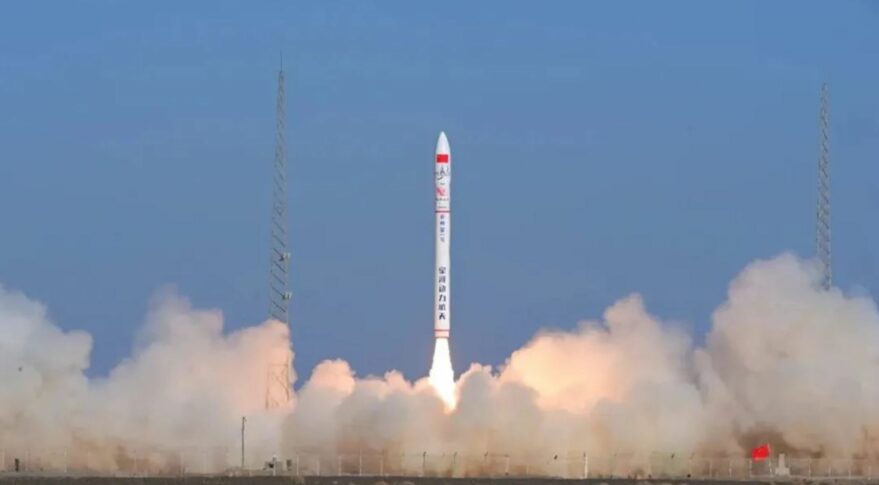
Pair of Chinese launches put classified and commercial satellites into orbit (Image Credit: Space News)
HELSINKI — China conducted its first two launches of 2023 over the weekend, sending three classified payloads into geosynchronous transfer orbit and five commercial satellites into sun-synchronous orbits.
A Long March 7A lifted off from the coastal Wenchang spaceport at 5:00 p.m. Eastern, Jan. 8, with unofficial, amateur video footage showing the rocket lifting off despite rain. The China Aerospace Science and Technology Corporation (CASC) confirmed launch success around 30 minutes later.
The main payload sent into geosynchronous transfer orbit (GTO) was revealed to be the Shijian-23 satellite developed by Shanghai Academy of Spaceflight Technology (SAST), a major CASC subsidiary.
The Shijian-23 satellite is mainly used for scientific experiments and technical verification. Two smaller payloads, Shiyan-22A and Shiyan-22B, were also onboard and will be used for in-orbit verification tests of new technologies such as space environment monitoring, according to Chinese state media.
The launch was the fifth of the Long March 7A, a three-stage version of the standard Long March 7 used to launch cargo missions to the Tiangong space station. It was also the fourth consecutive successful launch of the rocket, following the failure of the first launch in 2020.
The Long March 7A is a 60.1-meter-long, 3.35-meter-diameter kerosene and liquid oxygen launch vehicle with four side boosters, capable of delivering up to 7 metric tons of payload to GTO.
The rocket could replace the older, hypergolic Long March 3B, which launches from the inland Xichang spaceport in southwest China. By launching from the coast, the Long March 7A avoids the cost and hazards of the inland 3B launches, which have seen spent boosters fall on inhabited areas, and also has the advantage of launching from a lower latitude.
CASC’s China Academy of Launch Vehicle Technology (CALT), the rocket manufacturer, stated Sunday that it is currently able to produce 4-6 Long March 7A rockets per year, and up to 8-10 by 2025, suggesting the Long March 3B will remain active for years to come. Sunday’s mission used a 4.2-meter-diameter fairing but CASC is also working on replacing the 3.0-meter-diameter YF-74 hydrolox engine with a 3.35-meter YF-75D engine on the Long March 7A third stage, allowing it to support a 5.2-meter-diameter fairing,.
CASC stated last week that it again plans to launch more than 50 times this year. Last year it launched 53 Long March rockets and a Jielong-3 solid rocket from the Yellow Sea.
China’s second launch of the year followed early Monday, with a Ceres-1 commercial solid rocket from private firm Galactic Energy lifting off from Jiuquan spaceport in the Gobi Desert in northwest China at 12:04 a.m., Jan. 9. The company announced launch success within the hour, marking the firm’s fifth success from five launches. The first Ceres-1 launched in November 2020.
Five satellites were sent into sun-synchronous orbit (SSO), namely the Tianmu-1 01 and 02 meteorological satellites, a “Science and Technology-1” remote sensing satellite, Tianqi-13 for Guodian Gaoke and its Tianqi low-Earth orbit narrow-band Internet of Things constellation, and a small satellite for science outreach named for Nantong Middle School.
Galactic Energy is now looking to ramp up its production and delivery rate and plans 8-10 launches of the Ceres-1 in 2023.
The Ceres-1 rocket has a diameter of 1.4 meters, a length of about 20 meters, a mass at take-off of about 33 tons and a liquid propellant upper stage. It can deliver 400 kg to LEO or 300 kg to a 500-kilometer-altitude SSO.
The company is also working on its Pallas-1 reusable kerosene-liquid oxygen launcher. Pallas-1 will be capable of lofting 5,000 kilograms to low Earth orbit or 3,000 kilograms to 700-km SSO.
Last year Galactic Energy said a test launch could come as soon as during the first half of 2023, but the latest press release states only that development of the launcher will be continued during the year.








